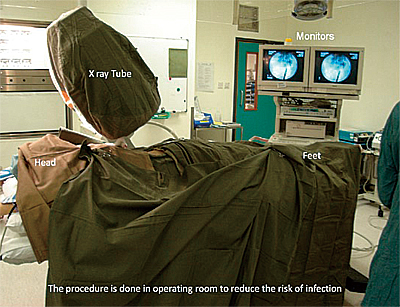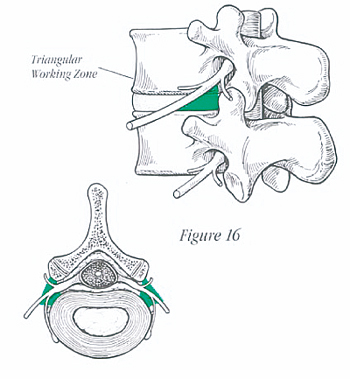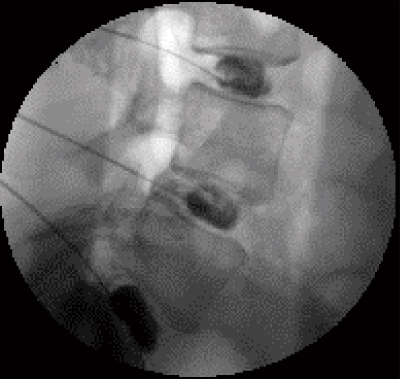Introduction
Accurate diagnosis of back pain isn’t always easy. The human spine is very complex, so it can be difficult to pinpoint the exact cause of low back pain or other symptoms. Additionally, other factors, like depression, anxiety, or stress, can contribute to the symptoms of back pain. MRI scanning is safe and produces outstanding images of the spine, but, unfortunately, it doesn’t show ‘pain’, therefore, in more complex cases of back pain it can often be very helpful to inject X-ray dye and local anaesthetic into the back to identify, and in some cases, treat, the painful structures.


History: Your doctor will ask you questions about your back problems, other related problems and your general health and past medical history. You may be asked to fill out a diagram that asks you where your symptoms of pain, numbness, tingling and weakness are occurring.
Physical Examination: Your doctor will examine your back for flexibility and range of motion. This often involves testing the strength of your muscles and your reflexes to make sure that they are still working normally.
X-rays: Your doctor will usually arrange a series of X-rays. X-rays show the bones, but do not directly demonstrate soft tissues, however if disc degeneration is present, the X-rays will often show a narrowing of the intervertebral disc spaces between the vertebral bodies, which indicates the discs have become very thin or have collapsed. Bone spurs, called osteophytes, can also form around the edges of the vertebral bodies and around the edges of the facet joints. As the disc collapses and bone spurs form, the space available for the nerve roots can also start to shrink.
X-rays are often performed sitting or standing with the individual bending forwards (flexing) and leaning back (extending) to demonstrate abnormal motion, known as instability.
Magnetic Resonance Imaging (MRI): is a non-radiation technique for imaging the spine that uses a magnetic field. It can demonstrate soft tissue structures, such as the spinal cord, intervertebral discs (Fig. 1), etc as well as bone.
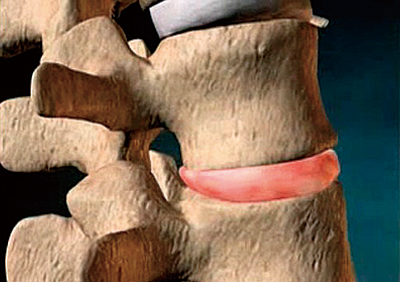
Fig. 1. Intervertebral disc
MRI is the single most useful test available for diagnosing spinal disorders.
MRI images are used to examine intervertebral disc height, hydration and a disc’s ability to exchange nutrients with its vertebrae.
Computed Tomography (CT) Scan: This uses a computer to produce detailed three-dimensional images of the body from a collation of cross-sectional X-rays. Of all the imaging techniques that are currently available, the CT scan is best able to produce images of bone.
Bone Scan: This procedure involves intravenously injecting a small quantity of a slightly radioactive marker into the patient’s vein, and then running a scanner over the area of concern. The scanner detects the marker, which concentrates in any region exhibiting high bone turnover. A bone scan is used when there is suspicion of tumor, infection, or small fractures, i.e., conditions that all result in high bone turnover.
Myelogram: This test procedure involves injecting a radiographic contrast media (dye) into the dural sac surrounding the spinal cord and nerves, and then taking X-rays of the spine. This demonstrates the nerve roots very clearly. Although this is a very high definition investigation, it is rarely used since MRI offers similar information without the need for an injection.
After baseline imaging studies of X-ray and MRI, most problems can be diagnosed with confidence. However, certain conditions such as when presentation is atypical, multiple level disease, prediction of the post operative outcome, complex problems (e.g. failed previous surgery) and anatomical variants may need injection tests.
Provocative Discography (PD): Provocative Discography (also called Provocative Disc Injection Test) has been used as a diagnostic modality for back pain since the middle of the 20th century [1]. It is an intricate procedure in which many factors play into the production of consistent, reliable, beneficial data in assisting the doctor to identify both the source of a patient’s pain, and the best possible treatment. It is an operator-dependent procedure in which the spine surgeon must use good clinical judgement to ascertain whether or not the patient is a good candidate for discography, what useful information may be obtained, and which technique to use.
Discography is not only to show the disc, but to identify problematic, injured intervertebral discs by reproduction of the patient’s usual pain complaint during the procedure.


An ongoing debate involves a comparison between magnetic resonance imaging of the spine, and the information obtained by discogram. MRI is an excellent imaging diagnostic tool that can differentiate between different parts of the disc. MRI can also be used to define details of the normal ageing process of the disc.
In single level disc disease, the pain origin is usually correlated to the MRI findings, however there is a 30% chance that the MRI findings are not typically correlated with the symptom.
In multi-level disc disease, the situation is even more confusing. Each individual abnormal disc may present differently.
To establish the relationship between the abnormal findings in the MR images and the clinical presentation, we need discography to help us to make an accurate diagnosis of the pain origin. Usually your doctor can also treat the pain by therapeutic injection at the same time in performing the discography.
The most common discography procedure is Transforaminal Epidural Steroid Injection.
The advantages of discography are:
- To correlate the relationship between the back pain symptom with the abnormal MRI findings. (To help your surgeon to select most appropriate choice of treatment for you) [2].
- To exclude non-painful disc from multiple level disc degeneration (2-3 levels of lumbar disc degeneration are common, especially in older people).
- Helping to decide which level needs surgery and how many levels need surgery [2].
- Positive prediction value in predicting the prognosis of pain relief after surgery. In a study regarding treatment for low back pain, pre-operative positive discogram findings correlated with an 89% sustained clinical benefit from operative intervention, whereas negative discogram findings correlated with only 52% success post-operatively [2,3].
- Pain injection therapy at the same time (for relieving the back pain – possibly preventing an operation).
- Minimal risk and suitable to almost any patient, except those with contrast or local anaesthetic allergy and pregnant women.
How to do Lumbar Discography?
You should not eat or drink for 2 hours before the procedure.
You will be admitted to day surgery ward of the hospital.
The procedure is done under local anaesthesia and you will be lying face down for 30 to 45 minutes (depending on how many levels and if additional procedures are required).
The level of injection will be confirmed by X-ray screening.
Your back will be covered with sterile drapes (Fig. 2).
Your doctor will use lignocaine (a local anaesthetic) to numb your skin.
Your doctor will pass a thin needle into the disc under X-ray guidance (Fig. 3).
Your doctor will inject contrast into the disc space to see if it reproduces your usual back pain (Fig. 4). This is called the Provocation Test.
Your doctor will be able to see the shape of the disc, and any tears and contrast leakage using X-ray screening.
|
Fig. 2 Setting in the operating theatre for discogram |
Fig. 3 The needle inserted into the disc space through a “safe zone”, labeled as green. |
Fig. 4 Intra-operative images of discogram |
The next step is the Relieving Test. Your doctor will inject lignocaine into the disc to see the pain relief response. We will record the change of the pain level one minute after the lignocaine injection. We might inject a normal disc for comparison if neccessary. However, we try to avoid this to reduce the further discomfort and potential disc degeneration of a normal disc after puncture.
Additional pain-relieving procedures, such as epidural steroid injection, is usually performed during the discogram.
What should I do and expect after the procedure?
Twenty to thirty minutes after the procedure, you can move your back to try to provoke your usual pain. You will report your remaining pain, (if any) and also record the relief you experience during the next week.
You may or may not obtain improvement in the first few hours after the injection, depending on if the disc injected is your main pain source. On occasion, you may feel numb, slightly weak or have an odd feeling in your leg for a few hours after the injection.
You may notice a slight increase in your pain lasting for several days as the numbing medication wears off before the cortisone is effective.
Ice will typically be more helpful than heat in the first 2-3 days after the injection.
You may begin to notice an improvement in your pain 2-5 days after the injection.
Occasionally, you may have some pain for longer than a week.
You may take your regular medications up to 2 weeks.
You may be referred for physical or manual therapy after the injection while the numbing medicine is effective and/or over the next several weeks while the cortisone is working.
Risks of Discography?
Risks of discography include discitis, neurologic and visceral injury, dye reactions, spinal headache and others. Spinal cord injury, vascular injury, pre-vertebral abscess, and subdural empyema have all been reported post-discography [4]. In 1995 it was recognized that the incidence of complications with discography were 0.15% per patient and 0.08% per disc [5].
The possibility that discography may cause persistent back pain since discography is generally performed in subjects with pre-existing back pain. Patients with significant emotional and psychological issues and chronic pain and those with disability claims account for more than 80% of those with persistent pain after experimental discography [6].
Selective Nerve Root Block (SNRB): This is injection test and/or therapeutic injection procedure for nerve root symptom (radiculopathy). This is done by injecting local anaesthetic and steroid on the nerve root under the X-ray guidance (Fig. 5). The equipment, pre-procedure preparation and technique are identical to discography.
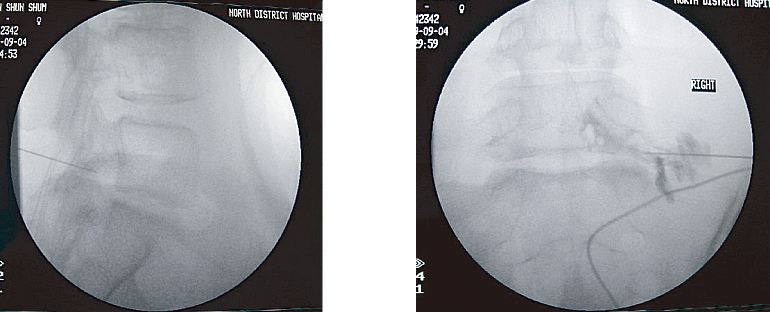
Fig. 5 Intra-operative Fluoroscopy of Selective Nerve Root Block Right L5 nerve root.
Left: Lateral view. Right: Antero-posterior view.
Facet or Sacro-iliac Joint Injections: Local anaesthetic injections into these joints are used to evaluate these joints as sources of low back pain. Judging by the effectiveness of the anaesthetic in relieving pain, a specific joint(s) producing back pain can be identified.


Low Back Pain is one of the most common reasons for a visit to the doctor. MRI is an excellent investigation but it does not show which level is painful. Discography is the most accurate investigation for identifying the source of the pain. Due to the multitude of presentations of spinal pain, in many cases, without discography, a definitive diagnosis cannot be made.
Discography may prevent patients from undergoing unnecessary surgery.
In patients having an operation, post-operative success has been shown to improve with the use of preoperative discography, especially in cases of multi-level disc problems.


- Palit M, Schofferman J, Goldthwaite N. Anterior Discectomy and Fusion for the Management of Neck Pain. Spine 1999; Vol.24 (21): 2224.
- Simmons EH, Bhalla SK. Anterior Cervical Discectomy and Fusion. A clinical and biomechanical study with eight-year follow-up. J Bone Joint Surg (BR) 1969; 51: 225-37.
- Colhoun E, McCall IW, Williams L, Pullicino VNC. Provocation discography as a guide to planning operations on the spine. J Bone Joint Surg (BR) 1988; 2:267-71.
- Zeidman SM, Thompson K, Ducker TB. Complications of cervical discography: analysis of 4400 diagnostic disc injections. Neurosurgery. 1995; 37 (3): 414-7.
- Guyer R, Ohnmeiss D. Lumbar discography. Position statement from the North American Spine: Society Diagnostic and Therapeutic Committee. Spine 1995; 20:2048-59.
- Carragee EJ, Chen Y, Tanner C, Hayward C, Rossi M, Hagle C. Can discography cause long term back symptoms in previously asymptomatic subjects? Spine 2000; 25(14): 1803-1808.
All Rights Reserved. Web Design by YSD


